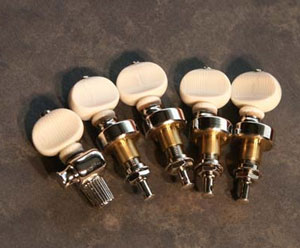Banjo Bridge Pegs
The banjo is a stringed instrument that was first developed in the 18th century. Certainly, there were different variations of the banjo, which were originated from different backgrounds. Nonetheless, it’s believed it was mostly developed in Africa and it was later brought to the United States. Today, the banjo is associated with country, bluegrass and even Irish music. This very well-known stringed instrument was later enhanced and even modified. You will find banjos with different number of strings, yet they are all built with banjo bridge pegs. These are used to tune the instrument to the correct key. Recently, the banjo has been incorporated in modern music, such as pop and indie.
A Bit of Background on Banjos
Even the very first banjo differed from the instrument we know today;the origins came from an African stringed instrument that featured a skin head. The neck was different – more of a stick neck – and the strings were tuned using some type of loops. It wasn’t until later in the early 19th century,when the instrument reached the Caribbean region, that the first banjo bridge pegs were incorporated. It’s worthy of mentioning that there are several other stringed instruments that are quite similar to the banjo. For example, in Japan the shamisen resembles the banjo quite a bit. But, when it comes to the banjo we know today, the first white person to ever play it in public was Joel Walker Sweeney; he did so in the 1830s and he modified it by adding a fifth string. The banjo bridge pegs were used to tune the five-string banjo to G-C-GBD.
Common Banjo Tunings
In general, all banjos are typically tuned to the key of G. However, this may change from one type of banjo to the other. If you’re a banjo beginner, don’t get discouraged if you’re unable to use the banjo bridge pegs properly. This is a skill that needs to be mastered with a lot of practice. It can be considerably helpful if you train your ear first. You can do this by watching other banjo players tune their instruments properly; you will have a better idea on how your banjo is supposed to sound like,once you tune the banjo bridge pegs. The most common banjo tuning is the key of G and it should be like the following:
- String 1 – D
- String 2 – B
- String 3 – G
- String 4 – D
- String 5 – G
Costs of Banjo Bridge Pegs
As you may have learned, banjos are typically tuned using friction bridge pegs and their price can vary. To give you a better idea on banjo bridge pegs prices, check the following listing by seller:
- Stew Mac –Waverly Tuning Pegs: set of 4 nickel pegs $94.95. Set of 4 gold pegs $125.00.
- Elderly Instruments –Grover Style Pancake Nickel Set of four pegs at $124.00 and gold set at $142.00.
- Music Man Steve – This is perfect for those searching for vintage parts. Pre-war banjo tuning pegs can be found starting at $150
- Janet Davis Music –Pancake Nickel Set of four pegs starting at $105.97
Keep in mind the prices for Banjo Bridge pegs can change. Make sure to contact the store directly for current prices and sales.

